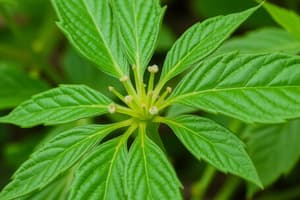Podcast
Questions and Answers
What is the primary source of energy for almost all living organisms, including animals?
What is the primary source of energy for almost all living organisms, including animals?
- Glucose (correct)
- Sunlight
- Water
- Oxygen
Which pigment is essential for photosynthesis in green plants, algae, and some bacteria?
Which pigment is essential for photosynthesis in green plants, algae, and some bacteria?
- Carotene
- Chlorophyll (correct)
- Phycocyanin
- Anthocyanin
In which type of photosynthesis is the pigment chlorophyll essential?
In which type of photosynthesis is the pigment chlorophyll essential?
- _C6 photosynthesis_
- _C4 photosynthesis_
- _C5 photosynthesis_
- _C3 photosynthesis_ (correct)
Which plant families are known to primarily utilize C4 photosynthesis?
Which plant families are known to primarily utilize C4 photosynthesis?
Which adaptation category helps plants reduce water loss and cope with high temperatures?
Which adaptation category helps plants reduce water loss and cope with high temperatures?
What is the main purpose of photosynthesis in plants?
What is the main purpose of photosynthesis in plants?
Which type of plants store water in their stem or leaves to survive drought?
Which type of plants store water in their stem or leaves to survive drought?
How do xerophytes like the boab withstand long periods without water?
How do xerophytes like the boab withstand long periods without water?
What is one way orchids obtain nutrients?
What is one way orchids obtain nutrients?
How do flowering plants attract pollinators?
How do flowering plants attract pollinators?
Which collaborative relationship involves plants growing in close proximity to nitrogen-fixing bacteria or mycorrhizal fungi?
Which collaborative relationship involves plants growing in close proximity to nitrogen-fixing bacteria or mycorrhizal fungi?
What is a common defense mechanism plants use to protect themselves?
What is a common defense mechanism plants use to protect themselves?
Flashcards are hidden until you start studying
Study Notes
Plants: From Photosynthesis to Adaptations
Plants are the foundation of our planet's ecosystem, transforming sunlight into energy and oxygen through a remarkable process called photosynthesis. This life-sustaining process, coupled with an array of fascinating adaptations, has allowed plants to thrive in diverse environments across the globe.
Photosynthesis
Photosynthesis is a metabolic process that combines sunlight, water, and carbon dioxide to produce glucose, oxygen, and other organic compounds that plants need to live. All green plants, algae, and some bacteria contain the pigment chlorophyll, which is essential for photosynthesis.
Plants convert light energy into chemical energy stored in glucose and release oxygen as a byproduct. This process is crucial for life on Earth: it provides the primary source of energy for almost all living organisms, including animals, and helps regulate our atmosphere by removing carbon dioxide and producing oxygen.
Plants use two primary types of photosynthesis: C3 photosynthesis occurs in most plants, while C4 photosynthesis is found in particular plant families, such as corn, sugarcane, and cotton. C4 photosynthesis is more efficient in warmer environments and helps plants to reduce water loss and minimize the negative effects of high temperatures.
Plant Adaptations
Plants have evolved a diverse array of adaptations that enable them to survive in challenging environments. These adaptations fall into several categories:
-
Water storage and conservation: Succulents like cacti and some desert plants store water in their stem or leaves to survive long periods of drought. In contrast, xerophytes, such as the boab, can withstand long periods without water by reducing their water loss through various means, like small leaves or waxy coatings on their leaves.
-
Nutrient acquisition: Some plants have developed unique ways to access nutrients or water from their environment. For example, orchids obtain nutrients from fungi, while others, such as the pitcher plant, lure and trap insects as a means of nutrition.
-
Reproductive strategies: Plants have developed various strategies to increase their chances of successful reproduction. For instance, flowering plants attract pollinators with bright colors and sweet nectar, while wind-pollinated plants have adapted to release pollen during windy periods. Other plants develop shrub-like forms or climbing mechanisms to reach the sunlight.
-
Symbiotic relationships: Many plants form symbiotic relationships with other organisms, such as bacteria and fungi. For example, mycorrhizal fungi form beneficial associations with plant roots, increasing nutrient and water uptake. In return, plants provide the fungi with carbohydrates.
-
Defense mechanisms: Plants have developed various defense mechanisms to protect themselves from herbivores and pathogens. For example, some plants produce toxic compounds to deter herbivores, while others develop thorns or spines to act as a physical barrier.
-
Collaborative strategies: Some plants have developed collaborative relationships with other plants or animals to increase their chances of survival. For instance, many plants grow in close proximity to their mutualist, such as nitrogen-fixing bacteria or mycorrhizal fungi, to improve their access to essential nutrients. Other plants, like brook cottonwood trees, rely on ducks to help disperse their seeds.
Plants are essential to our planet, maintaining the balance of our ecosystem and providing us with food, oxygen, and shelter. The fascinating process of photosynthesis and their diverse adaptations highlight the amazing ways that plants have evolved to thrive in their environment.
Studying That Suits You
Use AI to generate personalized quizzes and flashcards to suit your learning preferences.




